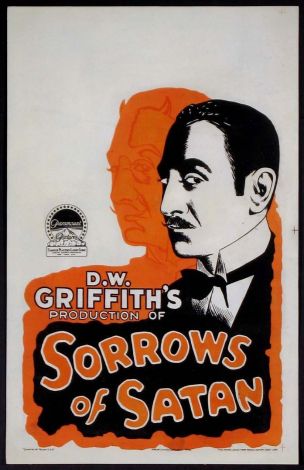The last of the three films that D. W. Griffith made at Paramount, The Sorrows of Satan is among the director's lesser known works, mostly owing to its failure in its own time. Adapted from the novel that made the reputation of bestselling Victorian author Marie Corelli, the movie is much more referred to than seen, in contrast to Griffith's classic works of the teens and early 1920s -- indeed, it is perhaps best known for the occasional reprinting of stills of its visually startling prologue sequence, depicting Lucifer's rebellion. The main body of The Sorrows of Satan does have its virtues, however, including three attractive leading performances, most especially Adolphe Menjou as Prince Lucia de Rimanez, the early disguise of Satan; Ricardo Cortez as the struggling author who sells his soul; and Carol Dempster, Griffith's protege, in perhaps the best performance of her career as the woman who resists Satan's temptations. And it's got a good story, albeit merely an adaptation of the Faust legend to modern times. The film's flaws lie in Griffith's inability to get a full handle on his material -- the Corelli original was already dated in 1926, and would have required an extremely deft hand at the helm, but Griffith reportedly never felt fully in sympathy with the project (which, by some accounts, he inherited from Cecil B. DeMille). A lot of the dramatic sequences run too slowly, and the director's reliance on extended tight close-ups didn't work for audiences in 1926 and are even less appealing today. Griffith does do well with Dempster's scenes, and his depiction of Menjou's seducation of Cortez's character are delightful to watch, principally because Menjou is always such a treat to see at work -- he makes a suave and beguiling Lucifer-in-disguise. But many of the shots linger too long, and some of the expository scenes are interminable. The prologue of Lucifer's rebellion, by contrast, is thoroughly bracing and so startling to watch, even in the worn and faded prints that mostly circulate today on this movie, that it ends up rendering the rest of the movie -- which does includes some scenes of horror and fantasy -- a bit of a disappointment. Still, as an artifact of Griffith's late silent period, it's worth seeing, and one wishes that there were better prints in circulation so that what is good about this film could be more thoroughly appreciated.

The Sorrows of Satan (1926)
Directed by D.W. Griffith
Genres - Drama, Fantasy, Romance |
Sub-Genres - Romantic Fantasy |
Release Date - Oct 12, 1926 (USA - Unknown) |
Run Time - 111 min. |
Countries - United States |
MPAA Rating - NR
Share on